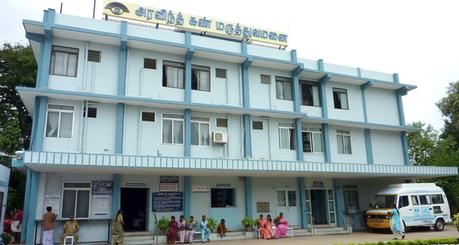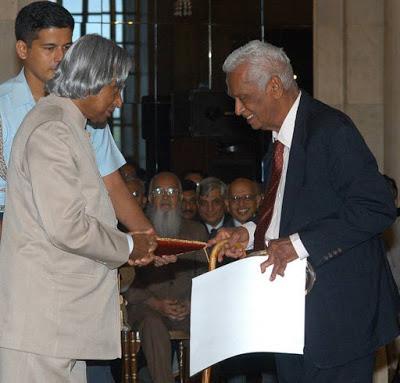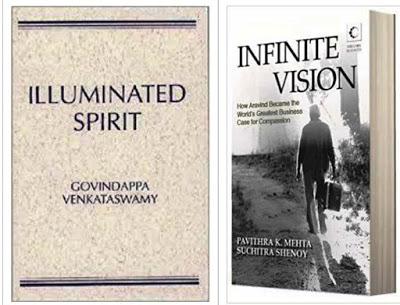Here is what New York times once wrote :‘Fixes looks at solutions to social problems and why they work’.As the United States struggles to find new business models for health care, some innovators are looking to other industries, ones that provide high-quality services for low prices. In a recent article in The New Yorker, for example, Atul Gawande suggests that the Cheesecake Factory restaurant chain — with its size, central control and accountability for the customer experience — could be a model of sorts for health care. That’s not as outlandish as it seems. The world’s largest provider of eye care has found success by directly adapting the management practices of another big-box food brand, one that is not often associated with good health: McDonald’s.
 To
get things done in a big and permanent way it must be done spiritually ~quote of a famous person on whom Google has a
doodle today. A man permanently
crippled by rheumatoid arthritis at age 30, alleviated sufferings of thousands
is indeed worthy of doodle.It is not in
cities alone, but in rural places that his vision, ensured vision for
masses.The photo here is a facility inaugurated
in 1985, as the first satellite hospital situate in Theni, along the Western Ghats 80 kms west of
Madurai, it serves an area within a 50 km radius, covering a population of 4.2
million including the Kottayam and Idukki districts in Kerala.
It is all about Dr.
G. Venkataswamy, affectionately called- 'Dr. V', the founder chairman of Aravind Eye Hospital.
He was born on today, 100 years ago (1.10.1918) in Vadamalapuram, a village
eighty kilometers from Madurai. He began his university education in the
American college, Madurai from which he graduated with a B.A. in chemistry. He
received his medical degree from Stanley Medical College at Chennai in 1944.
To
get things done in a big and permanent way it must be done spiritually ~quote of a famous person on whom Google has a
doodle today. A man permanently
crippled by rheumatoid arthritis at age 30, alleviated sufferings of thousands
is indeed worthy of doodle.It is not in
cities alone, but in rural places that his vision, ensured vision for
masses.The photo here is a facility inaugurated
in 1985, as the first satellite hospital situate in Theni, along the Western Ghats 80 kms west of
Madurai, it serves an area within a 50 km radius, covering a population of 4.2
million including the Kottayam and Idukki districts in Kerala.
It is all about Dr.
G. Venkataswamy, affectionately called- 'Dr. V', the founder chairman of Aravind Eye Hospital.
He was born on today, 100 years ago (1.10.1918) in Vadamalapuram, a village
eighty kilometers from Madurai. He began his university education in the
American college, Madurai from which he graduated with a B.A. in chemistry. He
received his medical degree from Stanley Medical College at Chennai in 1944.
 According to
Medical Council of India, India has 9.36 lakh doctors * (i.e. approximately 7.4
per 10,000 people). This also includes a significant number of inactive doctors
as well. If we look at WHO guidelines, it recommends 10 doctors for 10,000
people. Considering our ever growing population- there is always stunning shortage
of 3.3 lakh doctors just to meet the conservative guidelines in paper let alone
exceeding them. China has almost the double the ratio of doctors to people to
India and most of the developed countries have a ratio greater than 20 per
10,000 doctors.
Govindappa
Venkataswamy (1 October 1918 – 7 July 2006), an Indian ophthalmologist dedicated his life to eliminate needless
blindness. He founded Aravind Eye Hospitals, the largest provider of
eye care in the world. He is best known for developing a high quality, high
volume, low-cost service delivery model that has restored sight to millions of
people. Since inception, Aravind Eye Care System (a registered non-profit
organisation) has seen over 55 million patients, and performed over 6.8 million
surgeries. Its scale and self-sustainability prompted a 1993 Harvard Business
Case Study on the Aravind model.
Ignoring his
cripplement out of rheumatoid arthritis
at age 30, he trained as an ophthalmologist, and personally performed over
100,000 eye surgeries. As a government servant he helped develop and pioneer
the concept of eye camps.He was
honoured with Padma Shri from the
Government of India in 1973. In 1976, at the age of 58, he retired from
government service and founded Aravind in Madurai, Tamil Nadu along with his
four siblings and their spouses. The hospital began as an 11-bed clinic that
operated out of a rented house. Today, the Aravind Eye Care System includes a
network of 7 tertiary care eye hospitals, 6 secondary eye care centres, and 70
primary eye care centres in South India.
In 1992, Dr. V and
partners of Aravind founded Aurolab, an internationally certified manufacturing
facility that brought the price of the intraocular lens down to one-tenth of
international prices, making it affordable for developing countries. Today,
Aurolab manufactures ophthalmic pharmaceuticals, instruments and equipment, in
addition to intraocular lenses, and exports to 120 countries worldwide. Dr. V
was a disciple of spiritual teachers Sri Aurobindo and the Mother. In his
words: “Aravind Hospital aims at bringing higher consciousness to transform
mind and body and soul of people. It is not a mechanical structure repairing
eyes. It has a deeper purpose. It is not about buildings, equipment, money or
material things, but a matter of consciousness.” His life work is documented in
a film and book, both titled Infinite Vision.
According to
Medical Council of India, India has 9.36 lakh doctors * (i.e. approximately 7.4
per 10,000 people). This also includes a significant number of inactive doctors
as well. If we look at WHO guidelines, it recommends 10 doctors for 10,000
people. Considering our ever growing population- there is always stunning shortage
of 3.3 lakh doctors just to meet the conservative guidelines in paper let alone
exceeding them. China has almost the double the ratio of doctors to people to
India and most of the developed countries have a ratio greater than 20 per
10,000 doctors.
Govindappa
Venkataswamy (1 October 1918 – 7 July 2006), an Indian ophthalmologist dedicated his life to eliminate needless
blindness. He founded Aravind Eye Hospitals, the largest provider of
eye care in the world. He is best known for developing a high quality, high
volume, low-cost service delivery model that has restored sight to millions of
people. Since inception, Aravind Eye Care System (a registered non-profit
organisation) has seen over 55 million patients, and performed over 6.8 million
surgeries. Its scale and self-sustainability prompted a 1993 Harvard Business
Case Study on the Aravind model.
Ignoring his
cripplement out of rheumatoid arthritis
at age 30, he trained as an ophthalmologist, and personally performed over
100,000 eye surgeries. As a government servant he helped develop and pioneer
the concept of eye camps.He was
honoured with Padma Shri from the
Government of India in 1973. In 1976, at the age of 58, he retired from
government service and founded Aravind in Madurai, Tamil Nadu along with his
four siblings and their spouses. The hospital began as an 11-bed clinic that
operated out of a rented house. Today, the Aravind Eye Care System includes a
network of 7 tertiary care eye hospitals, 6 secondary eye care centres, and 70
primary eye care centres in South India.
In 1992, Dr. V and
partners of Aravind founded Aurolab, an internationally certified manufacturing
facility that brought the price of the intraocular lens down to one-tenth of
international prices, making it affordable for developing countries. Today,
Aurolab manufactures ophthalmic pharmaceuticals, instruments and equipment, in
addition to intraocular lenses, and exports to 120 countries worldwide. Dr. V
was a disciple of spiritual teachers Sri Aurobindo and the Mother. In his
words: “Aravind Hospital aims at bringing higher consciousness to transform
mind and body and soul of people. It is not a mechanical structure repairing
eyes. It has a deeper purpose. It is not about buildings, equipment, money or
material things, but a matter of consciousness.” His life work is documented in
a film and book, both titled Infinite Vision.
 pic credit : The Hindu
Dr. V remained a
bachelor. He lived with his younger brother G. Srinivasan (Aravind Eye Care
System's Director of Finance and Building) and his family. Former President of
India Dr. A.P.J. Abdul Kalam was a friend of his who wrote, "In the
Aravind experience I see the path we need to take --a transformation of life
into a powerful instrument of right action."
The vision of Dr V
- Aravind is not just a health success, it is a financial success. Many health
nonprofits in developing countries rely on government help or donations, but
Aravind’s core services are sustainable: patient care and the construction of
new hospitals are funded by fees from paying patients. And at Aravind, patients
pay only if they want to. The majority of Aravind’s patients pay only a
symbolic amount, or nothing at all. Aravind’s efficiency allows its paying
patients to subsidize the free ones, while still paying far less than they
would at other Indian hospitals. Each year, Aravind does 60 percent as many eye
surgeries as the United Kingdom’s National Health System, at one one-thousandth
of the cost.
pic credit : The Hindu
Dr. V remained a
bachelor. He lived with his younger brother G. Srinivasan (Aravind Eye Care
System's Director of Finance and Building) and his family. Former President of
India Dr. A.P.J. Abdul Kalam was a friend of his who wrote, "In the
Aravind experience I see the path we need to take --a transformation of life
into a powerful instrument of right action."
The vision of Dr V
- Aravind is not just a health success, it is a financial success. Many health
nonprofits in developing countries rely on government help or donations, but
Aravind’s core services are sustainable: patient care and the construction of
new hospitals are funded by fees from paying patients. And at Aravind, patients
pay only if they want to. The majority of Aravind’s patients pay only a
symbolic amount, or nothing at all. Aravind’s efficiency allows its paying
patients to subsidize the free ones, while still paying far less than they
would at other Indian hospitals. Each year, Aravind does 60 percent as many eye
surgeries as the United Kingdom’s National Health System, at one one-thousandth
of the cost.
 Aravind’s ideas
reach around the world. It runs hospitals in other parts of India with
partners. It is also host to a parade of people who come to learn how it works,
and it sends staff to work with other organizations. So far about 300 hospitals
in India and in other countries are using the Aravind model. All are eye
hospitals. But Aravind has also trained staff from maternity hospitals, cancer
centers, and male circumcision clinics, among other places. Some share
Aravind’s social mission. Others simply want to operate more efficiently.
The
vast majority of people blind from cataracts in rural India have no idea why
they are blind, nor that a surgery exists that can restore their sight in a few
minutes.
Aravind attracts these patients in two ways. First, it holds eye camps — 40 a
week around the states of Tamil Nadu and Kerala. The camps visit villages every
few months, offering eye exams, basic treatments, and fast, cheap glasses.
Patients requiring surgery are invited with a family member to come to the
nearest of Aravind’s nine hospitals; all transport and lodging, like the surgery,
is free.
Salute this great
man
With regards – S.
Sampathkumar
1st Oct
2018.
Aravind’s ideas
reach around the world. It runs hospitals in other parts of India with
partners. It is also host to a parade of people who come to learn how it works,
and it sends staff to work with other organizations. So far about 300 hospitals
in India and in other countries are using the Aravind model. All are eye
hospitals. But Aravind has also trained staff from maternity hospitals, cancer
centers, and male circumcision clinics, among other places. Some share
Aravind’s social mission. Others simply want to operate more efficiently.
The
vast majority of people blind from cataracts in rural India have no idea why
they are blind, nor that a surgery exists that can restore their sight in a few
minutes.
Aravind attracts these patients in two ways. First, it holds eye camps — 40 a
week around the states of Tamil Nadu and Kerala. The camps visit villages every
few months, offering eye exams, basic treatments, and fast, cheap glasses.
Patients requiring surgery are invited with a family member to come to the
nearest of Aravind’s nine hospitals; all transport and lodging, like the surgery,
is free.
Salute this great
man
With regards – S.
Sampathkumar
1st Oct
2018.

